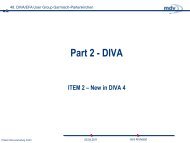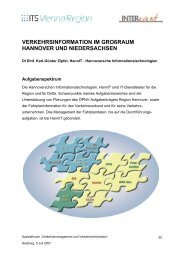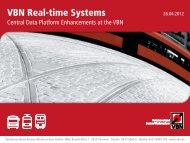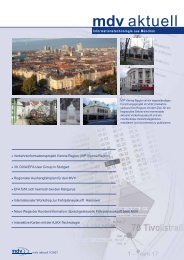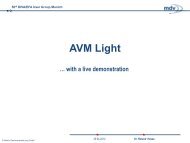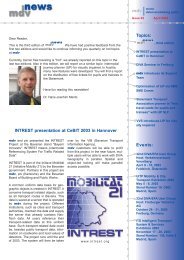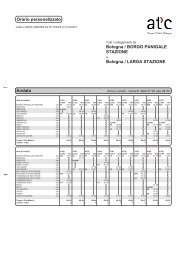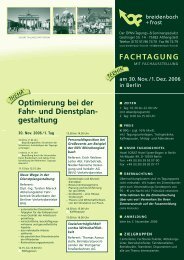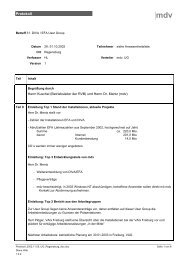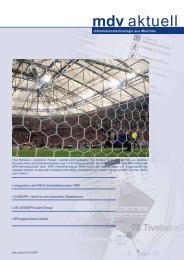Multi-modal Trip Planning for the San Francisco Bay Area - Mentz ...
Multi-modal Trip Planning for the San Francisco Bay Area - Mentz ...
Multi-modal Trip Planning for the San Francisco Bay Area - Mentz ...
Create successful ePaper yourself
Turn your PDF publications into a flip-book with our unique Google optimized e-Paper software.
8 mdv news I/2011<br />
AVM Light – Dynamic Timetables in <strong>the</strong> Vogtland Region<br />
The title of this article may pose a series of<br />
questions, even to <strong>the</strong> experienced mdv news<br />
reader. What is AVM Light? What do AVM and<br />
mdv have to do with one ano<strong>the</strong>r? And what is<br />
<strong>the</strong> Vogtland Region doing with this innovative<br />
technology?<br />
The idea to build AVM Light came about with<br />
<strong>the</strong> advent of powerful easy-to-use smart<br />
phones like <strong>the</strong> iPhone and Android phones.<br />
They provide enough processing power <strong>for</strong> <strong>the</strong><br />
functions of an AVM driver data terminal, can<br />
be easily installed in a vehicle, and are af<strong>for</strong>ded<br />
enough screen readability <strong>for</strong> use while driving.<br />
Newer phones would even provide an integrated<br />
GPS antenna <strong>for</strong> vehicle tracking. Yet real<br />
world use has shown that GPS antennas inside<br />
vehicles are much less reliable than an externally<br />
mounted device. Now <strong>the</strong>re are even<br />
off-<strong>the</strong>-shelf products of this kind as well.<br />
Behind <strong>the</strong> concept of AVM Light is <strong>the</strong> idea of<br />
having an AVM system without <strong>the</strong> hardware<br />
and vehicle installation. So <strong>the</strong> word 'light'<br />
mainly refers to <strong>the</strong> lack of hardware and its<br />
associated investment and maintenance costs,<br />
and not to its functionality.<br />
System Concept<br />
Regarding <strong>the</strong> vehicles, a distinction is made<br />
between those to be equipped with new data<br />
terminals and those that already have an<br />
onboard computer which only needs to be<br />
upgraded (see Figure 1).<br />
Vehicles without on-board computers will be<br />
equipped with two components, a GPS tracker<br />
and a PDA.<br />
The GPS Tracker is a GPS receiver with an<br />
antenna and integrated GPRS modem, which<br />
has been mounted on <strong>the</strong> roof of <strong>the</strong> vehicle<br />
and merely has to be connected to <strong>the</strong> vehicle’s<br />
electrical system. The GPS Tracker has its own<br />
SIM card and sends messages to <strong>the</strong> AVM system<br />
over <strong>the</strong> mobile network in customizable<br />
time intervals as soon as <strong>the</strong> vehicle is turned<br />
on. These messages indicate <strong>the</strong> GPS position,<br />
speed and direction of <strong>the</strong> vehicle as well as a<br />
vehicle-specific ID.<br />
In <strong>the</strong> vehicle, a PDA is installed on which <strong>the</strong><br />
application runs. Using this application, <strong>the</strong><br />
driver can log on at <strong>the</strong> beginning of <strong>the</strong>ir shift.<br />
AVM Light can work with or without block in<strong>for</strong>mation.<br />
The assignment of a vehicle to a trip or<br />
a block occurs when a driver logs on to a<br />
respective route/block.<br />
In addition to driver log on/off, vehicle and<br />
route registration, communication with <strong>the</strong><br />
center of operations occurs over <strong>the</strong> PDA. This<br />
is ei<strong>the</strong>r done via text messages or over <strong>the</strong><br />
telephone features of <strong>the</strong> PDA.<br />
Ra<strong>the</strong>r than having a GPS module in <strong>the</strong> PDA,<br />
using an external GPS track provides a number<br />
of advantages. Due to <strong>the</strong> high-quality antenna,<br />
receiver and installation on <strong>the</strong> vehicle roof, significantly<br />
more stable and reliable GPS reception<br />
can be achieved. Moreover, position and<br />
vehicle ID are sent whenever <strong>the</strong> vehicle is in<br />
operation, regardless of whe<strong>the</strong>r a route and<br />
driver are logged onto <strong>the</strong> system.<br />
In vehicles with on-board computers, position<br />
indication and log on/off communication <strong>for</strong><br />
routes have to be per<strong>for</strong>med by <strong>the</strong> on-board<br />
computer. Communication with <strong>the</strong> AVM system<br />
occurs over an interface that has been<br />
agreed upon by <strong>the</strong> manufacturer of <strong>the</strong><br />
computer.<br />
Control center<br />
Figure 2 shows <strong>the</strong> control center in correspondence<br />
with <strong>the</strong> DIVA / EFA system. It is from <strong>the</strong><br />
DIVA system that <strong>the</strong> AVM system is supplied<br />
with scheduled data via a VDV 452 interface.<br />
Based on <strong>the</strong> scheduled data and <strong>the</strong> current<br />
vehicle position, timetable <strong>for</strong>ecasts are calculated<br />
by <strong>the</strong> AVM system. The <strong>for</strong>ecasts are <strong>the</strong>n<br />
sent ei<strong>the</strong>r directly to EFA real-time or first to<br />
<strong>the</strong> DDIP via interfaces VDV 454 AUS and AUS-<br />
REF <strong>for</strong> use in <strong>the</strong> EFA journey planner. The vehicle<br />
positions are transmitted via <strong>the</strong> VDV 453<br />
VIS interface to EFA and to third parties over <strong>the</strong><br />
DDIP. The AVM system is also able to receive<br />
third party VDV 453 VIS to display <strong>the</strong>ir vehicles<br />
on <strong>the</strong> control center display.<br />
Both <strong>the</strong> application of <strong>the</strong> control center and<br />
<strong>the</strong> application <strong>for</strong> <strong>the</strong> vehicle data terminals<br />
run on <strong>the</strong> application server. Both applications<br />
are fully web-based. The control center application<br />
can be accessed in a browser on user workstations.<br />
The same applies to <strong>the</strong> use of vehicle<br />
data terminals, which also only require a<br />
browser on a PDA.<br />
Installation of AVM-specific software to user<br />
workstations or PDAs is not necessary.<br />
The applications on <strong>the</strong> application server communicate<br />
with <strong>the</strong> AVM system over a WCF<br />
interface. It is also possible to open this interface<br />
<strong>for</strong> communication between <strong>the</strong> AVM system<br />
and <strong>the</strong> on-board computers.<br />
Figure 1 Vehicle system Figure 2 Control center and data management system DIVA/EFA



